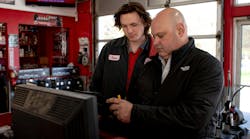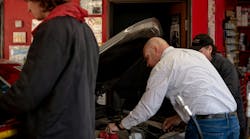The screensaver on my desktop computer at my NOLN office is a picture of an elephant walking through the savanna with a giraffe in the background. It is a picture that reminds me of my time in Tsavo West National Park in Kenya, Africa. If I am not careful, I can spend too much time staring at this picture and missing the beauty and the awesomeness of Tsavo. The elephant herds that live in the park are nicknamed the red elephants, mainly because of the red soil that covers the elephants after they roll around on the ground. But they are magnificent in size and in numbers. The lodge I stayed in was less than 50 yards from a popular watering hole, and all through the day and during the night, the elephant herds would come through and take advantage of the water hole. I could have easily sat on the porch and watched these nyekundu tembo (Swahili for red elephant) for hours.
Regardless of what you learned from nursery rhymes, the “king of the jungle” is not the lion, it is the elephant. While watching these amazing creatures, my mind wandered to the old saying, “How do you eat an elephant? One bite at a time.” This silly idea takes on a new perspective when you are a few yards away from them. In fact, it is almost ridiculous to even consider the idea; however, I guess it is true. Whenever you are facing enormous obstacles, the best approach to overcoming the problem is to break it down into bite-sized pieces.
2017 has been a good year for our industry. Of course, some shops are reporting numbers that are lower than expectations, but most are reporting above last year’s numbers. A few shops have consolidated, others have been a party to mergers and, still, others have been bought out altogether. Many shops have increased services and have invested in new equipment and technology to accommodate these new services. We have heard of several shops that have doubled down on the idea that they will be quick and efficient and concentrate on car counts at the sacrifice of ticket average. It seems that both models of operation can be successful and that local market conditions dictate the best approach.
The Big Elephant in the Room
It is true, the burdens in our industry seem bigger than before, so I thought I would break down the big concerns we have seen over the last few years into bite-sized pieces.Since the mid-1980s when I first happened on this industry, one rule still holds true today: control your inventory and labor costs, and you will make money in this industry. But how can we control these increases when our base price for an oil change has hit a plateau we can’t seem to get over? It is true that the big operations keep getting bigger, and the new car dealership service departments are entering into our space at a breathtaking pace. Both of these new mammoths are offering ridiculously low prices for oil changes and are using oil changes as “false leaders” to get people into their shops with their massive advertising campaigns.
However, something they are not saying is, so far, these massive campaigns have not been financially successful. In most cases, dealerships and the other large chain automotive service outfits are struggling to convert these lowball consumers when it comes to buying other services. In many cases, the real result is they are taking the lowball customer off our drives and leaving us room for the customers that have a genuine interest in maintaining their vehicles.
The reality is, a customer who is always chasing the cheapest price is really no customer at all — and is bogging down the shop and using up valuable resources. Some operators say thank you to the dealership for taking the lowballer and leaving them with more of the service-minded customer.
As of now, the big chain stores and dealerships seem to have one goal: to see how many things they can find wrong with the customer’s vehicle and then put the squeeze on the customer to try to upsell them. So far, it hasn’t worked on a large scale. Everyone knows that playing the “who’s cheapest” game never turns out well. Someone else will always be cheaper.
My advice is the same your mother told you as a child: be who you are, stay the course and continue to offer good service and good products at a reasonable price. Sometimes the best advertising you can do is to let your customer have a poor experience somewhere else.
Keep your inventory and labor costs to around 25 percent each, and you will make money. The quick oil and lube industry has several good point-of-sale companies that can show you how to use your system to do the math for you to help you make better decisions on inventory purchases and controlling labor costs. Call them. They are helpful. Once you get the data, then have the conversation with your suppliers about products.
The quick oil and lube industry is supported by good equipment, services and product companies that will bend over backward to help you. I see it all the time when I am out in shops. We have a good network of motivated vendors.
Recently, I noticed an article in Automotive News Fixed Op’s Journal magazine by Jeff Yip, “13 Tips for Tuning Up Your Quick-Service Operations.” It is worth repeating to our industry. At a minimum, here is a look into the dealership playbook. However, Yip’s points are valid for our industry to consider. Most likely, the dealership and big chain outfit in your market are considering these points.
As published in, Fixed Ops Journal April 2017:
“1. Be flexible. When you advertise your fast-lane service, make sure potential customers know they don’t need appointments. Then make sure you’re fully equipped to handle the workload.
“2. Have the right team. Fast-service experts recommend assigning a two-technician team and an adviser to every vehicle that comes through the express lane.
“3. Have the right tools. Your lube techs should have basic tools and a tool cart, including equipment for wheels and tires to make rotations quicker and easier.
“4. Compete on price. In your market, ‘call the independent shops to find out what they charge for the services you plan to offer,’ advises Ken Rock, customer care manager at Auto/Mate Dealership Systems, a dealership software provider in Albany, N.Y. ‘Match those prices, or keep them very competitive.’
“5. Build on your brand. ‘Your dealership’s main advantage,’ Rock says, ‘is that you use OEM parts. Customers may be willing to pay a small premium for that advantage, but ‘small’ is the key word here.’
“6. Upsell, but do it right. Joe Carroll is a division manager at M5 Management Services, a dealership consultancy in Pelham, Ala., that specializes in fixed operations. He says a quick-service operation should aim to sell 60 percent of all services the adviser recommends the customer have done.
‘The adviser should show the customer a menu of services the manufacturer calls for and ask: ‘Would you like us to take care of that if it needs it?’’ Carroll says. ‘That way, you already have authorization. If you don’t present it, you’ll never sell it.’
At the same time, Rock says, remember that service customers are suspicious of efforts to sell them work and products they think they don’t need.
‘We are here to advise the customer on the proper way to care for their major purchased equipment,’ he says.
‘Don’t lie, don’t try to scare them. Verifying that something is really needed, and not just guessing,’ is an essential part of that process, Rock adds.
“7. Make the wait less painful. Waiting areas, including those for quick-service customers, should offer free Wi-Fi service and cellphone chargers, Rock says.
‘It’s no good trying to charge for something that everyone else gives away,’ he says.
“8. Use quick service to boost overall customer satisfaction. Rick Law, general manager of Big Star Ford in Manvel, Texas, says his dealership surveys its quick-service customers and acts promptly on complaints.
‘We want to drive our loyalty scores up,’ he says.
“9. Turn service customers into vehicle buyers. Shaheen Chevrolet in Lansing, Mich., operates an eight-bay, $2.5 million quick-service center. The dealership assigns customer care employees to its waiting area. Customers who express interest in trading in their vehicle are introduced to a salesperson.
“10. Bring customers back. Big Star Ford sells Advantage Care, a bundle of three oil changes, tire rotations and car washes, for $99. Law says the offer is popular among quick-service customers and attracts repeat business.
“11. Hire for tomorrow. Today’s lube tech can become tomorrow’s full-fledged service technician. Look for good candidates.
“12. Don’t drop the ball. Carroll advises dealerships to provide continuing, adequate training to overcome the high turnover rate among lube techs.
‘You have to tell the new employees: ‘This is a good job.’ The [dealers] who struggle are the ones who are throwing bodies at that department, and not coaching and not mentoring,’ he says.
“13. Take the long view. Law says he doesn’t look at his dealership’s fast-service operation, which is not a Ford Quick Lane outlet, as a profit center. Instead, he sees the service as ‘a window where people can see we’re going to do such a good job with Ford techs that they’ll want to come back. If we can wow somebody in the quick lane, we feel we can make them a customer for life.’
Adds Tom Hernly, service manager of Shaheen Chevrolet: ‘It takes something like $2,700 in resources to attract each new customer. The last thing we’re going to do is tick off a [quick-service] customer over $35.
‘There’s no sense in arguing with the customer,’ Hernly says. ‘If there’s an issue, it’s free. That’s the bottom line.’”
Worrying about the elephant in the room is not going to make him go away.
Since the industrial revolution swept through our country in the mid-1800s, there have always been challenges in staying relevant. It is these challenges that make us better in what we do. There is plenty of opportunity for our industry to succeed. What are you doing to compete with the dealership or big chain outfit in your market?





